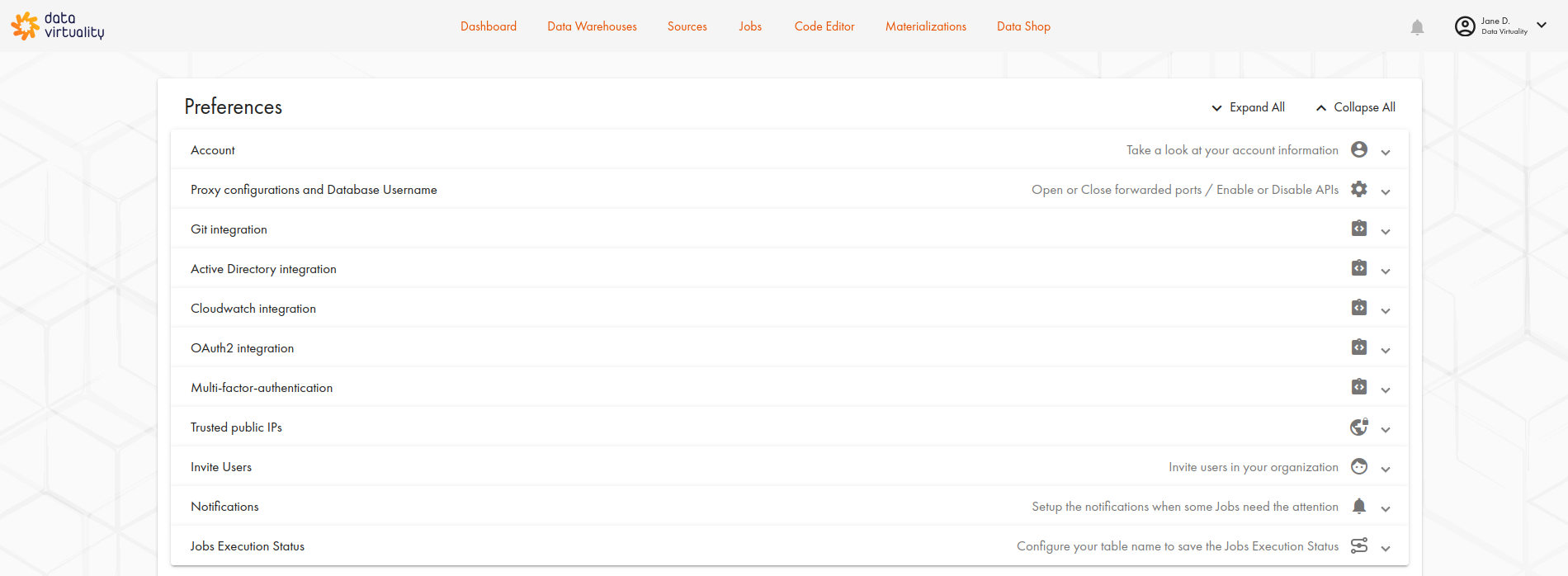Preferences
You are looking at an older version of the documentation. The latest version is found here.
Preferences are available in the menu under your name in the Web UI's top right corner. Here is what they look like when collapsed:

Account
Here you can check your account information: name, company name, user name, and email.
By default, the same email address is used for email notifications if something requires your attention and you have enabled email notifications, but you can go to the Notifications section below and enter any email address you wish to use for notifications.
If you want to change your password, you can use the Change Password link in the menu under your name in the top right corner.
If you are trialling the Data Virtuality Platform, the section will also show how many days you have left.
Proxy Configurations and Database Username
This section displays your database name which you will need for connecting via ODBC, JDBC, OData, and Data Virtuality Studio, information on ports for ODBC and JDBC, and your REST API endpoint. The ports and REST API endpoint are enabled by default, but you can disable any of them by toggling the switch.
Git Integration
This functionality is coming up soon in Data Virtuality Platform SaaS, and it is already available in Data Virtuality Platform On-Premise.
Active Directory Integration
This functionality is coming up soon in Data Virtuality Platform SaaS, and it is already available in Data Virtuality Platform On-Premise.
Cloudwatch integration
This functionality is configured by our support and operations team on the backend side.
OAuth2 Integration
This functionality is coming up soon in Data Virtuality Platform SaaS, and it is already available in Data Virtuality Platform On-Premise.
Multi-factor Authentication
This functionality is coming up soon in Data Virtuality Platform SaaS, and it is already available in Data Virtuality Platform On-Premise.
Trusted Public IPs
These are IP addresses from which Data Virtuality accesses data. Please whitelist them on your firewall.
Invite Users
Here you can add colleagues to your instance so they can work with it, too.
Notifications
By default, notifications are disabled: the Data Virtuality Platform generally runs independently and does not require watching over it. You can enable notifications by toggling the switch under the type of notifications you like most (at present, we support Slack and email notifications) or both so that Data Virtuality will let you know if something requires your attention.
Email notifications use the email address you have provided during signup by default (it can be changed to another email address). Slack notifications use Slack WebHooks and require some manual actions - please see below for step-by-step instructions. Both types of notifications are sent hourly.
Slack Notifications
This type of notification uses Slack WebHooks and requires some manual actions. Here's how to set up Slack notifications for Data Virtuality:
Click the link under the Slack field. You will be redirected to Slack App Directory's Incoming WebHooks page, and you might need to log in to your Slack workspace.
In the Post to Channel section, select the channel to which you want the notifications to come and click Add Incoming WebHooks integration.
On the next page, go to the Integration Settings section, find and copy the Webhook URL, return to the notifications settings in the Pipes preferences, and paste it into the Slack field.
Toggle the Enable Slack notifications switch and save your settings.
This is all you need to do - you do not have to go through the setup instructions on the Slack page, as we have already configured the WebHook for you. If you wish, you can go through the Integration Settings section: change the channel for posting notifications, customize the name and icon for incoming messages, and add a description.
Email Notifications
Email notifications are, by default, sent to the email address you indicated during registration. If you want to use a different email address, you can enter it in the Email field. The Use my email button will set the notifications to the email indicated in the Account section. Do not forget to toggle the Enable Email notifications switch under the Email field and save your settings!
Notifications are sent from platform@datavirtuality.de.
Jobs Execution Status
Jobs execution status is a log of all unique job chains and can be configured to be stored as a table in your data warehouse. By default, the table name is job_status, and you can change it to anything you like.
